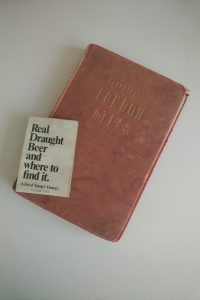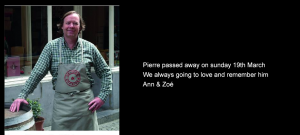Part 1 – Genesis
Strong’s of Romsey. On holiday we drove to the market town of Romsey, even before we had got out of the car, the smell was unbearable, I mean really unbearable to this child. I demanded we leave the town. My other early recollection of beer was after the fortnightly visit to Nana and Grandad, my father was often visibly stressed afterwards and before driving home we would stop at a pub. At the very least this was crisps and a fizzy drink in the car, sometimes a garden, better if it had a swing. Dad emerged after one pint, visibly relaxed. The jury was out on beer at this point but pubs were definitely good places.
Manfully overcoming my traumatic experience in Romsey and glossing over my date of birth and the legality of it, I started drinking in the early seventies. Bottles of cider and then brown ale were the beginning. Malty, sweet brown ale was excellent boys ale and a part of me still hankers after that, the memory is surely of a beer far better than it was. As we got older and it became worth a punt trying to get served inside pubs it was immediately clear that the stuff to drink was the beer that came out of the handpumps. Writing now in my dotage, I wonder why this was? Beer and fizzy drinks just didn’t seem to go together, however much Watney’s might have wanted us to believe it. The Europeans made lager but that was a continental thing – “Fine Ales & Continental Lagers” – and definitely not British, probably something to do with their climate. Paradoxically this was also the heyday of the ‘light and bitter’, a bottle of light/pale ale and a half of bitter in a pint glass. Light ale was a pale, thin, bitter concoction of the worst kind, in my humble opinion. I firmly believe that nobody actually liked light and bitter despite them saying things like ‘it freshens up my pint’. Rubbish. The reason they bought it was that the half of bitter was more than likely going to be on the generous side and in those days bottles were less expensive so you got more beer for less money.
There were 14 pubs in Molesey by the time I was of legal drinking age, 7 remain. Though I mourn the passing of a couple, to be honest, seven is enough. And there are a few of bars and casual dining places where you can get a beer. Courage houses dominated and the beer was OK, Courage Best was never spectacular but was a solid pint back in the day, Directors was a tad sweet (as stronger beers always were back then) and more full bodied. My recollection is that most of these pubs had handpumps. Across the river at Hampton Court was a Sam Smiths pub and in Hampton Hill we found a free house, rare in those days, with Theakston’s Old Peculier. The closest pub to my mates was a ghastly new 70’s build called The Surveyor BUT it had Fuller’s – Chiswick Bitter (not much to it), London Pride (a great beer, always was) and the strong, sweet ESB. At 5.5% it was ridiculously strong for our tender age and any of our group who attempted an evening on it got very messy (yes Richard [not me, the other one] that’s you).
There were two seminal moments of my teenage drinking years. The Covent Garden Beer Festival and my first pint of Young’s. I have no recollection how I heard about the beer festival, but hear about it I did. We were also aware of CAMRA and while fully supporting them we had no need and no money to become members. Remember in these days free houses were rare, each town might have, say, three brewers represented in it and those brewers had a virtually unchanging line-up of beers. So I was like a kid in a candy store faced with all these different beers. No idea what I drank but it was tremendous fun! My only clear recollection was of an old water tap in the wall above which some wag had written ‘Watneys’.
I like to think my first of Young’s was in the packed, smoky, Grey Horse in Kingston listening to live trad jazz though to be honest I can’t remember precisely. I had heard about Young’s, it was considered Marmite beer at the time. It was the only beer my father would actively avoid. Well, dear reader, I became married to it. This was beer with character, flavour but above all, by the standards of those times, bitterness. A bitterness balanced with a good malt body. Not long afterwards we became used to seeing occasional people come into a Young’s pub, order a pint and then pass over a document which was signed and returned.
Intrigued we approached the landlord and discovered that, although unpublicised, if you picked up a list of Young’s pubs (always prominently displayed in every pub), got a signature from every landlord and returned it to the brewery you could claim a free pin of beer and receive a Young’s tie with CXLVII proudly emblazoned on it. And so was born our preferred weekend evening entertainment for four or five years.
Evenings were well planned, especially when further afield so that we didn’t miss just one pub, new additions to the estate were scribbled on, I think we actually visited about 152. For those of you that have grown up with Youngs and Geronimo pubcos, Young’s pubs were a very different kettle of fish back in the day. Some were nice middle class saloon bar type pubs but many were much of the ‘spit and sawdust’ variety, definitely sawdust anyway. In short a lot of them looked like really rough pubs, in reality none were. Much the same as today in my opinion, nice people like good beer and we had some great evenings, especially when the locals knew we were doing the list.

Interspersed with the Young’s years was my university life in Bristol. Courage predominated there too, not even Courage Best but the very weak and boring Courage B.A., Boys Ale as we called it. Our local had a passable pint of Usher’s (before it was subsumed by Watney’s/Grand Met) and the highlight was Donnington’s, not a spectacular beer but just an excellent session bitter. We only knew of one pub in the centre until a second opened close to the biochemistry building, the Scotsman and his Pack. (Still the only pub where I have seen someone lower a parasol, roll a joint, put it back up and sit there smoking it. Give him a break, it was after finals.)
Our former Venture Scout master, Ken, with whom we ‘messed around in boats’ had a cutter in Portsmouth harbour and through that we were introduced to Gales, phenomenally good beer when on song, usual routine was to have a pint of BBB then a pint of HSB and decide which was drinking best that evening.
Ken also went to the Oktoberfest on a regular basis, what was there not to like about this idea? Colin, Ian, Richard and I set off in Richard’s tank (an oldish battleship grey Rover) armed with 2 tents and road map of Europe. Two days drive down, three days there, two days back and with instructions to avoid the Hofbrau tent (drunken, brawling Aussies apparently). The beer was a ‘when in Rome’ thing but somehow it didn’t taste like the thin nasty stuff that passed itself as lager in the UK, but the Oktoberfest wasn’t about the beer really. Each day we’d arrive, four 20ish larrikins and be seated with a German family, three generations, both sexes – and we’d get on famously. Sure by the end of the day they’d have gone home in good spirits while we bumbled drunkenly around, each one of us randomly getting lost but somehow we all got back to the campsite each night. It really opened our eyes to a different way of drinking, one that is only very slowly beginning to change forty years on in the UK.
After university and a couple of rented flats my first purchase was in west London and I became more fully acquainted with Fuller’s. One year they ran a ‘passport’ scheme and all 125 pubs were duly done for faux earthenware stein and growler as I recall. It was fun but did not have the frisson of the Young’s days. Fuller’s rightly had its devotees. Malty Fuller’s or hoppy Young’s, much the same as today’s malty Sambrook’s or hoppy Twickenham Fine Ales.
At the same time some of my old university friends started working in the City and the Princess Louise became the venue for Christmas and any other excuse drinks. Always a little shabby, occasionally smelly, very Sam Smiths, this pub is completely timeless as a visit last year proved. The Firkin pubs were fun but the highlight of my early eighties drinking was The Orange Brewery in Pimlico, one of the first independent brewpubs I encountered, they also sold hops to home brewers (home brewers did not have much access to real leaf hops in those day). The beers were simple and characterful, SW1 and SW2.
And then as the eighties progressed and the nineties started my cask ale intake reduced. First Dry Blackthorn cider, and then when the cider:Rennies® ratio became unacceptable, Guinness became my tipple of choice. No idea why, maybe just I wasn’t going in decent beer pubs.
Beerwise I began to drift a little. In France I was happy to drink the widely available draught Leffe and realised that fizzy, mass produced beer could be okay. In Germany I was introduced to wheat beer, this was definitely a good thing though I have never quite got their dunkel beers. Hoegaarden was a natural progression, another enjoyable, mass produced, fizzy beer. Having read about the romance of spontaneous fermentation I did manage to order a gueuze on the French/Belgian border, thoroughly enjoyed it but seeking it out and being able to pronounce it were a hurdle too far so the baton was dropped on what would later become a great love affair.
By the mid-nineties I was beginning to make business visits to the USA, at first to Boston. I was quickly alerted to Sam Adams, another good mass produced, fizzy, beer (yeah, yeah, I know it’s classed as a craft brewery, it isn’t, but that doesn’t stop it being good). Then on a trip to Salem I had a beer with about 100g of blueberries floating in it, it was for me at the time, totally leftfield and I loved it. The bar was full, it was a great bar, and everyone was drinking this stuff. The USA was not just a choice of Bud/Coors/Miller as we’d been told. Something was happening here, and it was exciting.
Agog to find out what Rich drank next? Part 2 – Revelations featuring Garrett Oliver, Logan Plant and a cast of beards including the epiphany evening, the Beer Bloggers Conferences and much more, coming soon…



